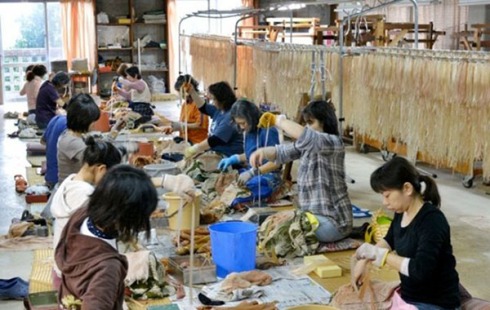
Figure [1] Chris Ashton, 2013, ‘Local women peeling the banana stalks into strips’
By Catrina Xu
The practice of traditional Japanese textile techniques has long survived through generations. Traditional textile techniques have been preserved to help in defining culture heritage. Many techniques are derived from individual historical areas in Japan. Such as yuki-tsumugi, a silk production technique found along the Kinu River in Yuki City and Oyama City, north of Tokyo. This technique specifically uses rejected silkworm cocoons that are either empty or deformed.
Until modern times artisans who are masters of traditional textile techniques have found struggles in preserving their practices through future generations. With the eruption of popularity of consumerism of fast fashion in the new modern society, the disinterest in old traditional practices is alarming. In Japan consumers would rather turn to inexpensive garments made from new technologies that produce materials from synthetic fibres that require excessive use of heat, water and chemicals. The respect, appreciation and patience for older traditional textile techniques are slowly fading.
Thus is why in 1954, Japan brought out the law establishing ‘Cultural Properties Protection’. This law enforces protection upon ‘Intangible Cultural Properties’ that contribute to historic and artistic value for Japan. These properties vary from music, craft techniques, stage arts, etc. This law enforces recognition amongst technical artistries that embody the highest mastery of textile techniques in Japan. Making sure that these cultural property skills are being carried on.
It is easy to state that a law will provide the recognition of textile techniques and the practice and masteries will be continued. The contemporary world is continuously evolving, with newer technologies and demands, the control of consumerists are out of our hands. Traditional textiles are viewed as practices that represent as a significant subject of Japanese culture, but there is a low demand these techniques in the new contemporary consumer market.
There are many textile techniques in Japan that possess production methods that are sustainable, benefiting the environment. Such as the practice that produces the fabric called Basho-Fu. This textile is derived and exclusively produced on the island of Onkinawa, Japan. Basho-Fu is a hand woven textile, made from fibres produced from ‘itobasho’, a type of wild banana found on the island of Onkinawa. New emerging technologies where synthetic materials and practices that are low in cost are more preferred through mass production. The Cultural Properties Protection law may promote recognition for traditional textiles, but the escalation of fast fashion shows no appreciation for masters of textiles. The process to make basho-fu involves a long process of extracting fibres from the stalk, boiling and then rinsing. Even the dyeing process requires a lot of time and patience. The slow processes and higher costs of traditional textiles that require patience simply do not keep up with the fast and evolving pace of fast fashion and consumerism.
In order to find space in the market, we must find a niche for these Japanese textiles to survive and become desirable in the world of fast fashion chains and department stores. Japanese textile techniques will always be appreciated as a practice that is a part of Japanese heritage. As the modern world is changing, masters and artisans must evolve with present and future times. In order to prevent traditions being replaced by cheaper techniques, they have to be adapted in order to sustain the cultural heritage of Japanese textiles. These practices do not suit the environment and nature of fast fashion. These techniques belong in a world of luxury goods. A market where consumers are willing to pay the price for textiles where they are respected not only for the heritage and culture features but for the appreciation for the skills and long processes artisans have applied to.
Reference:
[1] Ashton, C., 2013, ‘Local women peeling the banana stalks into strips’, Yahoo, viewed 21st January 2017, https://au.be.yahoo.com/travel/a/16440720/okinawa-japans-fountain-of-youth/#page1
McCarty, C. & McQuaid, M., 1998, Structure and Surface: Contemporary Japanese Textiles, The Museum of Modern Art, New York
Intangible Cultural Heritage, Yuki-tsumugi, silk fabric production technique, Paris, viewed 19th January 2017, http://www.unesco.org/culture/ich/en/RL/yuki-tsumugi-silk-fabric-production-technique-00406
Okinawa Island Guide, Pride of Okinawa: basho-fu, Okinawa, viewed 29th January 2017, https://www.oki-islandguide.com/specialfeatures/pride-of-okinawa-basho-fu
Kukatsu, Y., 2014, ‘Traditional Textile Design for Social Innovation Toward Sustainability in Japan’, Textile Society of America Symposium Proceedings, paper 915, viewed 19th January 2017, http://digitalcommons.unl.edu/cgi/viewcontent.cgi?article=1902&context=tsaconf
I found this interesting, knowing that Japan has different textile techniques such as the yuki-tsumugi, a silk production technique specifically uses rejected silkworm cocoons and other textile techniques made from fibers called the itobasho which is a type of wild banana. To improve on this blog, I wish you could have written more information regarding more varieties of textile techniques.
LikeLike
I would have never thought that Wild Bananas could be transformed into a textile especially when it has been produced for a very long time and is a traditional technique in Japan. It is wonderful to explore this area as it can be recognised and can possibly be used in the industry in order to keep these artisans going with their techniques. And also Im guessing it is eco-friendly especially recycling something to be turned into something that could be used in garments and accessorie in the future.
I strongly agree with you on how these century old traditional techniques should be considered within the luxury sector and definitely not in fast fashion. In this industry, we need to acknowledge the significance of how much time and skills it takes for an artisan to produce their textile, since it will be something unique and valuable. And you have explored this area in a strong manner, which is effective.
LikeLike